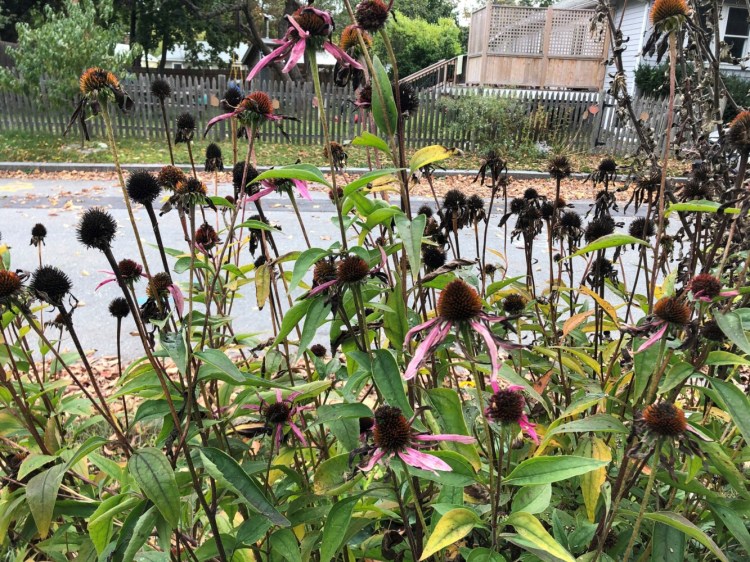Garden cleanup started earlier than normal this year. That cleanup consisted mostly of raking up acorns – more than 100 gallons of them according to my bucket-based calculations – before most of the leaves had fallen.
Although we try to compost plants that grow on our property, the acorns go straight to the town transfer station. I might be denying squirrels and chipmunks food, but those rodents already eat too many of our strawberries and tomatoes. I don’t want the pests – cute pests, yes, but still pests – fat, healthy and hungry when those crops become ripe next year. Moreover, the acorns in the chopped fallen leaves that I compost over the winter never seem to break down at all. Instead, they turn into small oak trees that we have to weed out the next year in the vegetable garden. I want to avoid that.
Here is how I put our gardens to bed in the fall.
Cleanup of the vegetable garden is straight-forward. Remove everything except the perennial crops, such as asparagus, rhubarb and strawberries. Any plant material that might have disease traces – mostly squash and tomatoes – goes to the transfer station shortly after the first frost. The last crops to come out of what we still call our vegetable garden are dahlias and gladioli, because they should be killed by a frost before being dug, dried and stored for the winter.
Cover the naked (except for garlic and perennial crops) garden with something that prevents erosion and adds organic matter. Cover crops such as oats, barley and rye or leaf mold (last year’s decomposed leaves) all work.
The lawn is also simple, although, as I wrote recently, do think about replacing a lot of your lawn with groundcovers. All the publications say that if you have a thin layer of fallen leaves, just mow with a mulching mower, and the leaves will provide nutrition to the grass. I don’t know anyone in Maine who gets that few leaves, which means for you leaf removal, raking is required to prevent the leaves from smothering the grass.
Before raking, mow the lawn as short as possible without scalping the sod. We load the leaves onto tarps and haul them to compost bins that I create from wood pallets. For the past two years, I’ve put the leaves through an electric leaf grinder. It’s extra work and a bit noisy (though not as noisy as mowers or leaf blowers), but it results in better leaf mold the following year and means I need fewer compost bins.
The cleanup debate comes with the perennial borders, where herbaceous perennials and annuals are mixed with shrubs and small trees. The woodies, of course, remain. The rest is debatable.
Some people leave everything in the beds until spring. The dying vegetation provides shelter and food for beneficial insects and other wildlife. It is the more natural way. But “provides shelter and food for beneficial wildlife” means it also protects pests, like voles, that can damage your yard. In addition, there are more spring garden chores than fall ones; getting the cleanup done in the fall frees time for planting in the spring.
My wife Nancy and I fall in the middle of the two extremes. We want our gardens, which we can see all winter while we are stuck inside the house, to look good. The dying plant material is messy. It used to be that the mess was unimportant because it would be covered by snow all winter. But climate change is happening, and at least along the coast of Maine, much of the winter is snowless – meaning we have to look at the bare gardens.
We get rid of any plants that flop to the ground once the foliage dies. These include daylilies, hosta, most irises and such plants. We let plants stand that look good through the winter like coneflowers, black-eyed Susan, sedums and grasses. Not only do they look good, but some of them drop seed, giving us free plants for future seasons.
Just one more thing to welcome in the spring.
Tom Atwell is a freelance writer gardening in Cape Elizabeth. He can be contacted at: tomatwell@me.com.
Send questions/comments to the editors.



Success. Please wait for the page to reload. If the page does not reload within 5 seconds, please refresh the page.
Enter your email and password to access comments.
Hi, to comment on stories you must . This profile is in addition to your subscription and website login.
Already have a commenting profile? .
Invalid username/password.
Please check your email to confirm and complete your registration.
Only subscribers are eligible to post comments. Please subscribe or login first for digital access. Here’s why.
Use the form below to reset your password. When you've submitted your account email, we will send an email with a reset code.